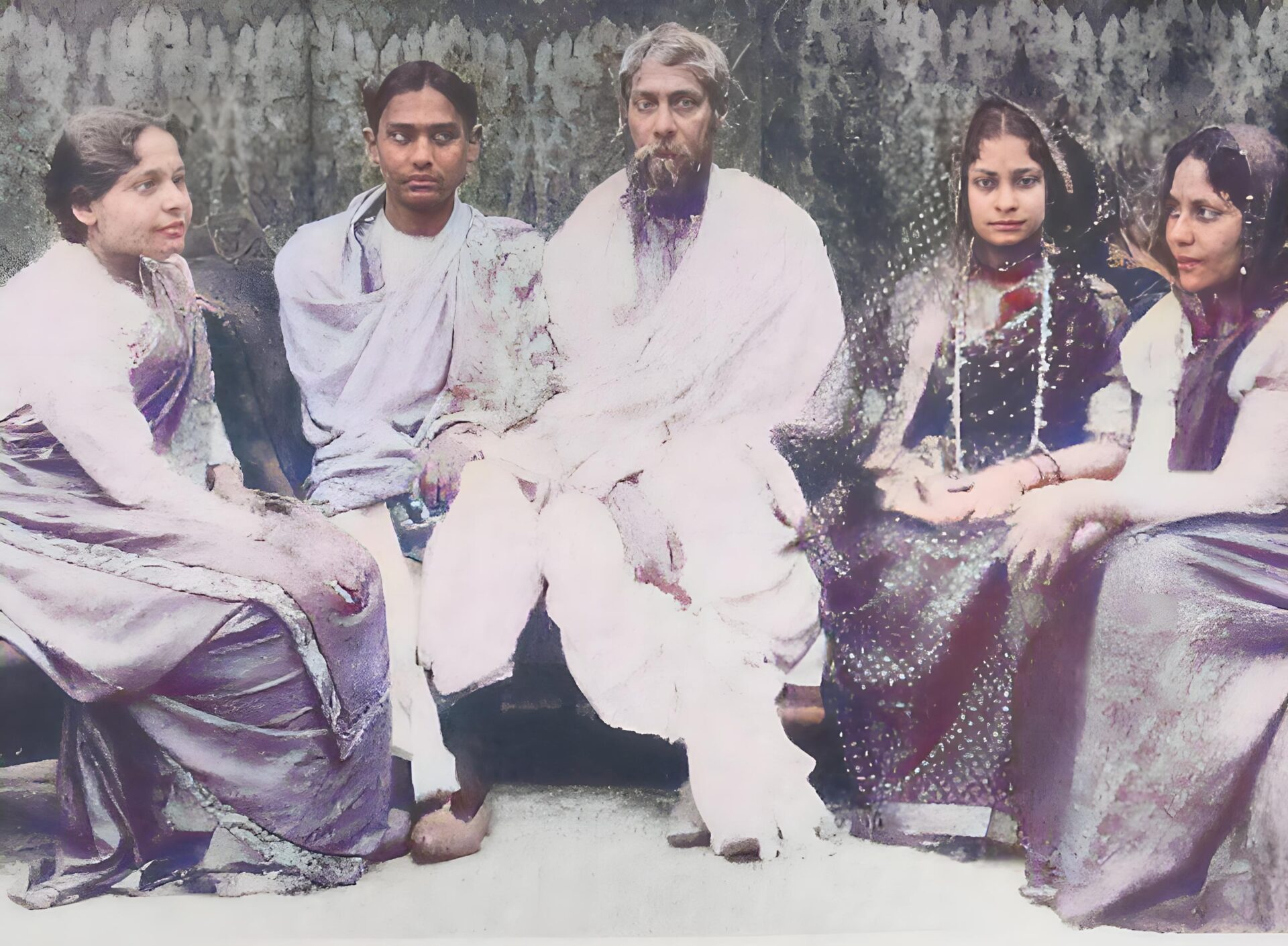
Rabindranath Tagore (1861-1941) was a towering figure in Indian literature and culture, and his contributions as a poet, philosopher, and social reformer have left an indelible mark on the world. Born into a family deeply rooted in the spiritual and intellectual movements of 19th-century Bengal, Tagore was a unique blend of tradition and modernity. He drew upon India’s spiritual heritage while embracing global humanism, making him an influential voice both in the East and the West. This article delves into his extraordinary life, his works, and his lasting legacy.
Summary of Rabindranath Tagore’s Life and Works
| Aspect | Details |
|---|---|
| Full Name | Rabindranath Tagore |
| Birth | May 7, 1861, Calcutta (now Kolkata), India |
| Death | August 7, 1941, Shantiniketan, India |
| Father | Debendranath Tagore |
| Education | Educated at home; briefly attended University College London, did not complete studies |
| Nobel Prize | Awarded Nobel Prize in Literature in 1913 for Gitanjali (Song Offerings) |
| Notable Works | Gitanjali (1910), The Home and the World (1916), Gora (1910), Manasi (1890), The Post Office (1912) |
| Major Contributions | Poetry, plays, novels, short stories, music, social reform, education, art |
| Educational Initiative | Founded Shantiniketan (later Visva-Bharati University) with a focus on holistic and creative education |
| Political Engagement | Supported Indian independence, renounced knighthood in protest of British policies after the Jallianwala Bagh massacre |
| Music | Composed over 2,000 songs known as Rabindra Sangeet |
| Art | Produced paintings and drawings, known for their bold colors and abstract forms |
| Legacy | Influenced global literature and culture; India’s national anthem Jana Gana Mana is his composition |
Early Life and Education

Rabindranath Tagore was born on May 7, 1861, in Calcutta (now Kolkata), India, into the prominent Tagore family. His father, Debendranath Tagore, was a key figure in the Brahmo Samaj, a progressive religious movement that sought to revive the monistic spiritual philosophy of the Upanishads, focusing on the universal unity of existence. This spiritual and intellectual environment deeply influenced Rabindranath from a young age.
Tagore was educated at home, a rare privilege at the time, allowing him to study a variety of subjects ranging from literature and music to science and art. He was exposed to classical Indian texts and Western literature, fostering a broad worldview. At the age of 17, he was sent to England for formal education, attending University College London. However, he did not complete his studies, returning to India to pursue his literary ambitions. His brief stay in England, though, enriched his understanding of Western culture and ideas, influencing his later works.
Early Literary Success
Tagore began writing at an early age and quickly gained recognition for his work in Bengal. His early poetry collections, such as “Manasi” (1890) and “Sonar Tari” (1894), received critical acclaim. These works showcased his mastery of language, his deep connection to nature, and his philosophical insights into human existence. He was not merely a poet but a thinker who sought to capture the essence of life’s spiritual and emotional dimensions.

Though initially known only in Bengal, Tagore’s fame spread internationally when he translated some of his poems into English. His collection “Gitanjali” (1910), which means “Song Offerings,” was particularly significant. The English version, published in 1912, introduced him to Western readers and earned him the Nobel Prize for Literature in 1913, making him the first non-European to receive the prestigious award. His eloquent expressions of love, devotion, and unity resonated deeply with audiences worldwide.
Social Reformer and Educator
Beyond his literary achievements, Tagore was a visionary social reformer who was committed to improving the lives of the common people. His management of the family estates in rural Bengal brought him into close contact with farmers and laborers, sharpening his awareness of the inequalities and injustices they faced. This experience fueled his desire to promote social reform, particularly in the areas of education and rural development.
In 1901, Tagore founded an experimental school at Shantiniketan, a rural town in Bengal, which later grew into the renowned Visva-Bharati University. The school was based on Tagore’s educational philosophy, which emphasized a holistic, harmonious approach to learning. Drawing inspiration from the Upanishads and other spiritual texts, Tagore envisioned an educational system that nurtured creativity, critical thinking, and a sense of interconnectedness with nature. Shantiniketan became a model for progressive education, attracting students from across the world.
Political Engagement and Nationalism
Though not primarily a political figure, Rabindranath Tagore was deeply involved in India’s struggle for independence. He had a close relationship with Mahatma Gandhi, whom he referred to as “Mahatma,” meaning “Great Soul.” While Tagore admired Gandhi’s dedication to nonviolent resistance, he often took a more spiritual and philosophical approach to nationalism. Tagore advocated for freedom that went beyond political independence, emphasizing the importance of intellectual, cultural, and spiritual liberation.
In 1915, the British government knighted Tagore for his contributions to literature. However, in 1919, following the Jallianwala Bagh massacre, in which British troops killed hundreds of peaceful Indian protesters, Tagore renounced his knighthood in protest. His act of defiance was a powerful statement against British colonial policies and further solidified his position as a moral leader in the fight for Indian independence.
Literary Legacy: Poetry, Plays, and Novels
Rabindranath Tagore was a prolific writer, producing works in virtually every literary genre. His poetry remains his most celebrated contribution to literature, but he also made significant contributions in the fields of drama, fiction, and essays. His major poetry collections include:
- “Manasi” (1890) – Often considered his first mature work, it reflects his evolving philosophical and aesthetic outlook.
- “Sonar Tari” (1894) – A symbolic exploration of the human condition, filled with vivid imagery of nature and the divine.
- “Gitanjali” (1910) – His most famous work, which brought him international acclaim. The poems explore themes of devotion, love, and the search for the divine.
- “Balaka” (1916) – A collection of poems that focus on the idea of flight, both physical and metaphorical, representing the human spirit’s yearning for freedom.
In addition to poetry, Tagore was an accomplished playwright. His major plays include “Raja” (1910) [The King of the Dark Chamber], a philosophical drama about the search for truth, and “Dakghar” (1912) [The Post Office], which explores themes of life, death, and spiritual liberation. “Raktakaravi” (1926) [Red Oleanders], another significant play, critiques the dehumanizing effects of industrialization and exploitation.
Tagore also wrote several novels that grappled with complex social and political issues. “Gora” (1910), one of his most significant works, explores themes of identity, religion, and nationalism, while “Ghare-Baire” (1916) [The Home and the World] delves into the conflict between tradition and modernity during India’s nationalist movement.
International Recognition and Global Impact
Rabindranath Tagore’s impact was not limited to India. His travels across continents, particularly his lecture tours in Europe, the United States, and Japan, made him a global ambassador of Indian culture and spirituality. Tagore’s message of unity, peace, and understanding resonated with audiences worldwide, especially during a time of global turmoil following World War I.
His philosophical vision of universalism, which transcended national boundaries and religious divisions, made him a symbol of cross-cultural dialogue. Tagore believed that humanity was interconnected through shared experiences of love, suffering, and the search for truth. His works continue to inspire individuals and movements dedicated to fostering peace and understanding across cultures.
Artistic Contributions: Music, Painting, and More
While Tagore is best known for his literary works, he was also a gifted musician and artist. He composed over 2,000 songs, known as Rabindra Sangeet, which blend classical Indian music with folk traditions and Western melodies. These songs remain popular in Bengal and across India, with many of them being performed during cultural festivals, national events, and personal celebrations.
Tagore’s creativity also extended to the visual arts. Late in life, he took up painting, producing a series of striking artworks characterized by their bold colors and abstract forms. Although less known than his literary achievements, Tagore’s paintings have been exhibited in galleries across the world, earning him recognition as a multifaceted artist.
Final Years and Legacy
Rabindranath Tagore’s final years were spent in Shantiniketan, where he continued to write, teach, and engage with global intellectuals and leaders. Despite suffering from illness in his later years, he remained active in literary and social spheres until his death on August 7, 1941.
Tagore’s influence endures not only in India but also globally. His works continue to be translated into multiple languages, and his ideas on education, social reform, and cultural unity remain relevant. In India, his song “Jana Gana Mana” was adopted as the national anthem, a testament to his lasting impact on Indian identity.
Rabindranath Tagore was more than a poet; he was a philosopher, an educator, a social reformer, and a global humanist. His works transcended linguistic, cultural, and national boundaries, making him a universal figure of wisdom and creativity. Through his poetry, plays, novels, music, and social initiatives, Tagore articulated a vision of life that remains as profound and inspiring today as it was during his lifetime. His legacy as a literary genius and a champion of human values continues to shine brightly in the cultural and intellectual landscapes of the world.
FAQs on Rabindranath Tagore
1. Who was Rabindranath Tagore?
Rabindranath Tagore (1861-1941) was an Indian poet, philosopher, social reformer, and artist. He was the first non-European to win the Nobel Prize in Literature in 1913 for his work Gitanjali (Song Offerings). He is also known for composing India’s national anthem, Jana Gana Mana.
2. What is Rabindranath Tagore famous for?
Tagore is best known for his poetry, particularly his collection Gitanjali, as well as his contributions to education, social reform, and Indian cultural renaissance. He also wrote plays, novels, short stories, essays, and songs.
3. What are some of Rabindranath Tagore’s notable works?
Notable works by Tagore include:
- Gitanjali (1910)
- Gora (1910)
- The Home and the World (1916)
- Manasi (1890)
- The Post Office (1912)
4. What was Tagore’s contribution to education?
Tagore founded the school at Shantiniketan in 1901, which later became Visva-Bharati University. His educational philosophy emphasized creative freedom, self-expression, and the integration of nature and learning.
5. How did Rabindranath Tagore participate in India’s independence movement?
Tagore supported India’s independence movement but took a more spiritual approach compared to political leaders. He renounced his knighthood in protest of British policies, especially after the Jallianwala Bagh massacre in 1919.
6. What is Rabindra Sangeet?
Rabindra Sangeet refers to over 2,000 songs composed by Rabindranath Tagore. These songs are an integral part of Bengali culture and Indian music, blending classical and folk elements.
7. When did Rabindranath Tagore die?
Rabindranath Tagore passed away on August 7, 1941, in Shantiniketan, India.

